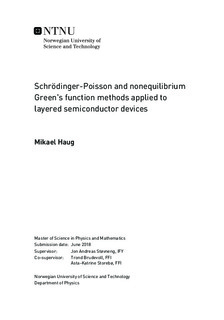| dc.description.abstract | In this work, electron transport through layered semiconductor heterostructure devices in the nanometer dimension are simulated. Because these devices have shrunk in the last decades, it is no longer sufficient to utilize only semiclassical transport theory. This is because it neglects quantum mechanical effects such as tunneling, interference and confinement. Thus, the need for a fully quantum mechanical corrected theory arises. The application for these devices range range within the fields of nanoelectronics, optoelectronics and flexible or stretchable electronic devices. Both of the methods are compared; the semiclassical theory uses a Schr{\"o}dinger-Poisson solver, and the fully quantum mechanical theory uses a nonequilibrium Green's function method. Both methods are studied in one dimension for electron transport, in the singleband approximation. Since there are spatial charges throughout the device, these will affect the shape of the electric potential profile. So, the Schr{\"o}dinger-Poisson solver first calculates the quantum mechanical states from the Schr{\"o}dinger equation, with an initial ansatz for the potential profile. Then, the states that are obtained are substituted into the Poisson equation, which takes into account spatial charges and calculates a new potential profile. The profile is substituted into the Schr{\"o}dinger equation again, and the process is iteratively repeated. The problem is that one must make an assumption for the electron density involved in the Poisson equation, which does not take into account inelastic scattering effects of the electrons. In the nonequilibrium Green's function case, the same ansatz for the potential profile is used. Once the Green's functions have been calculated, the electron density may be obtained and substituted into the Poisson equation for calculations of a new profile. The resulting profile obtained is substituted into the Green's function equations, and the process is iteratively repeated. The result is that the less accurate but more rapid semiclassical approach is traded off for a much slower but simultaneously more accurate fully quantum mechanical theory. | |

